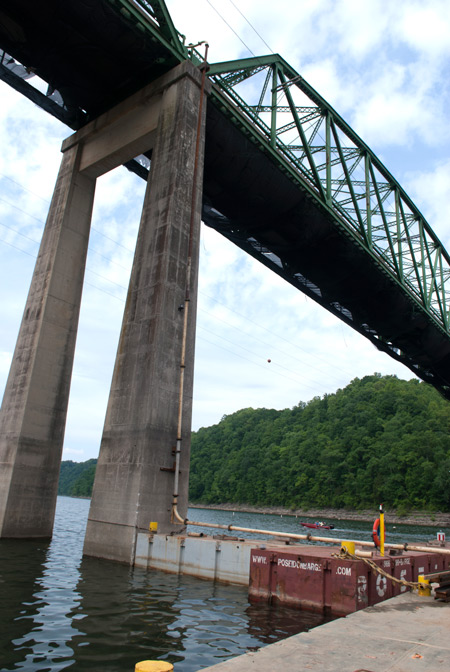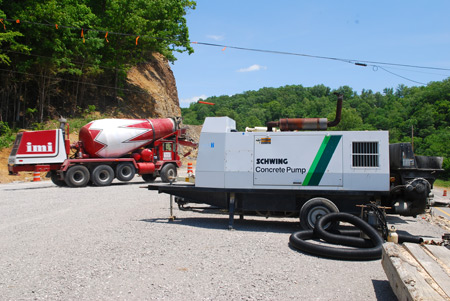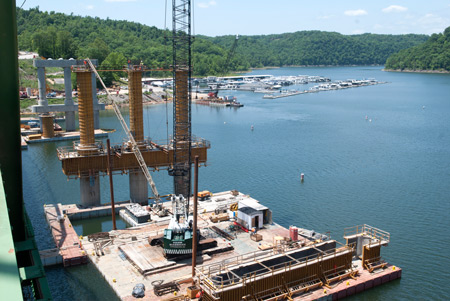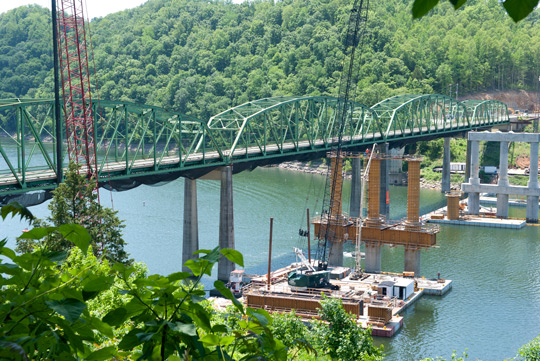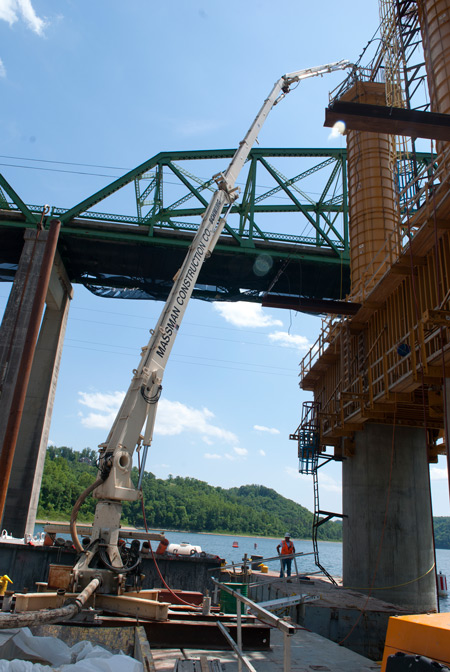Deep Caissons Pumped w/ Separate Placing Boom

Replacing the Hwy 70 bridge over Caney Fork River between Sparta and Smithville, TN is anything but normal. Because the State has plans to widen the route in the future, the design calls for a support structure of cast-in-place concrete that could accommodate four lanes of traffic. The current $38 million contract held by Massman Construction, Kansas City, MO calls for a two-lane welded steel bridge on the four-lane substructure. And because the Caney Fork River was dammed in the late 1950s the Caney Fork River forms Center Hill Lake at the Hwy 70 crossing.
“Because the reservoir is not navigable, we had to truck everything to the site – cranes, barges, pumps,” according to Massman Senior Project Manager, Dale Helmig. It took over 250 trailer loads to bring in five cranes up to 300-ton capacity, barges large enough to support the massive lifting equipment, a Schwing SP 4800 concrete pump and 31-meter separate placing boom. The process of pinning together 10-ft x 40-ft modular barge sections, assembling five cranes and support equipment took two months beginning in April 2013.
The new bridge is being built 60-feet north of the existing bridge which spans 1200-feet of the lake. Caissons up to 150-feet deep and 11.5-feet in diameter were drilled to bedrock and the resulting piers formed from concrete pumped with a tremie pipe. The SP 4800 is pumping from both sides of the river and up to 1150-feet of five-inch pipeline has been assembled to reach the pier work at times. “Some of the piers took more than 575-yards of concrete just to break water,” Helmig states, “From there we add a 30-foot shaft extension of poured-in- place concrete, then we pump the strut that ties a set of three piers together, add an eight-foot diameter column and eight-foot cap. At that point we are 90-feet above the water.” There are three sets of three piers being constructed in the channel and one set of piers on land to support the new bridge. Concrete abutments on both banks are also being pumped as part of the contract.
In order to reach to the top of the piers, Massman utilizes a barge-mounted Schwing three-section 31-meter pacing boom. The hydraulic boom mounts on a pedestal that is bolted to an X-frame welded to the barge. A diesel power pack accompanies the boom. The pipeline from pump to boom is laid over the existing bridge and barges in 10-foot lengths with heavy-duty clamps. A one cubic-yard thrust-block near the pump embeds the first section of pipe to reduce movement. “We have to maintain a 190-foot open channel at all times which is why we have pumped from both sides of the river, “ according to Helmig.
The SP 4800 is maintaining volume and distance requirements on the job with a 443-hp diesel powering an open loop hydraulic system with eight-inch diameter pumping cylinders. The pump features high-volume and high-pressure settings that can be switched depending on the application. A high pressure Rock Valve with dual shifting cylinders complements the 2020-5 150/90 pump kit that can generate 2364 psi on the concrete. “We have several Schwings that have performed well with very little maintenance which is essential in these out-of-the-way locations,” says Helmig.
“We have been able to pump up to one hundred yards per hour at times, but we average sixty-five to eighty yards per hour most of the time,” Helmig notes, “Some of the larger volume piers have taken ten hours of continuous pumping.” Pumping through the crane-supported tremie pipe puts the end in fresh concrete so that the rising concrete from the bottom displaces the water without washing out the cement content. After priming the pipeline, a ball is inserted which pushes out any water in the line and concrete follows.
Because of the depth of some of the caissons, the tremie pipe is in two sections. As concrete rises in the caisson, the placing boom’s tip section connected to the pipe also rises. When the junction in the tremie pipe emerges from the concrete, the pump is stopped, the top section of tremie pipe is disconnected and removed, the tip section of the boom is reconnected in a matter of minutes so pumping can resume with the tremie never leaving the concrete.
Because the lake level is influenced by the U.S. Corp of Engineers Center Hill Dam, the reach of the placing boom has been very valuable. “We have had to adjust on the fly, sometimes the guys are working in waders pouring a pier extension that is normally out of the water, “ Helmig says, “Of course the placing boom adjusts constantly.” The placing boom has been at full extension of 101-feet when pumping to the top of the pier caps. The Roll and Fold design of the boom does not interfere with the tremie pipe movement.
Poured struts will be pumped to tie the piers together and the welded steel bridge will be constructed by Fall 2015. The current bridge will stay in use until the ribbon cutting of the new structure. By then hundreds of trucks will have hauled Massman’s equipment on to other projects, which are numerous. Dale Helmig, the company’s cast-in-place specialist, will have departed earlier. A statement on Massman’s website says it best, “Our success comes from working smart. We rely on our own in-house construction engineers and experienced field supervisors, who leverage state-of-the-art equipment and techniques.”
Specs:
Owner: State of Tennessee
Contractor: Massman Construction Co., Kansas City, MO
Pumping Equipment: Schwing SP 4800 stationary pump, Schwing SP 31-meter placing boom.



